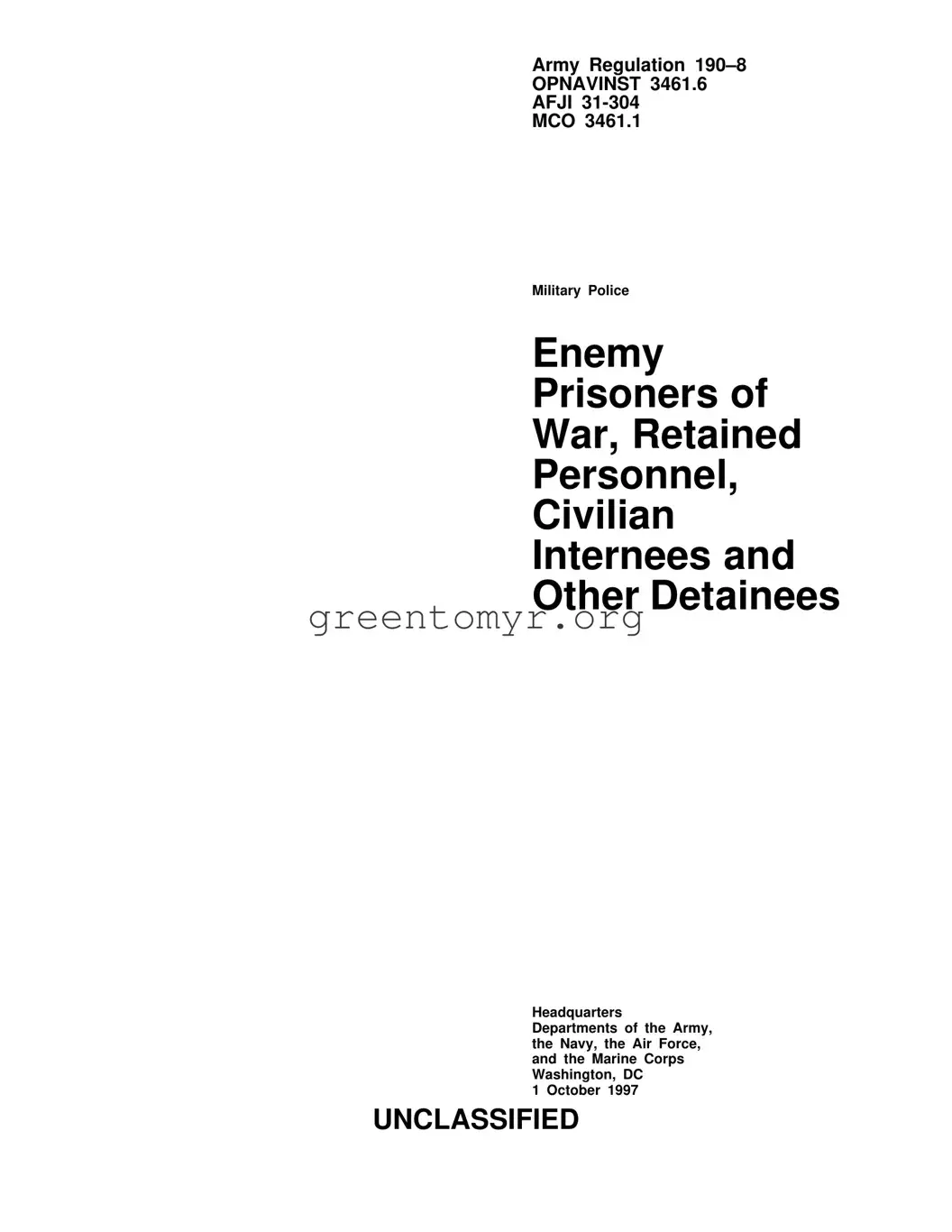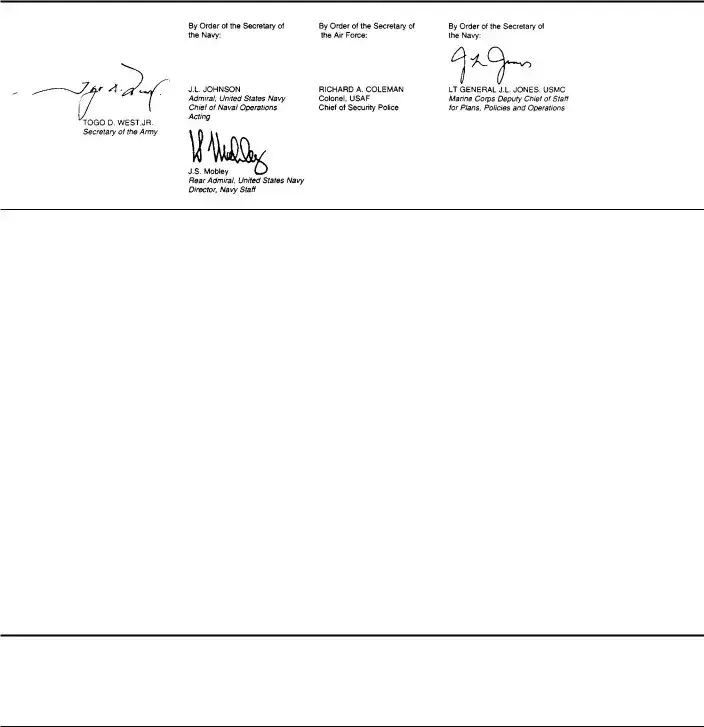Chapter 1
Introduction
1–1. Purpose
a. This regulation provides policy, procedures, and responsibili- ties for the administration, treatment, employment, and compensa- tion of enemy prisoners of war (EPW), retained personnel (RP), civilian internees (CI) and other detainees (OD) in the custody of U.S. Armed Forces. This regulation also establishes procedures for transfer of custody from the United States to another detaining power.
b. This regulation implements international law, both customary and codified, relating to EPW, RP, CI, and ODs which includes those persons held during military operations other than war. The principal treaties relevant to this regulation are:
(1)The 1949 Geneva Convention Relative to the Amelioration of the Condition of the Wounded and Sick in Armed Forces in the Field (GWS).
(2)The 1949 Geneva Convention for the Amelioration of the Condition of Wounded, Sick and Shipwrecked Members of Armed Forces at Sea (GWS SEA).
(3)The 1949 Geneva Convention Relative to the Treatment of Prisoners of War (GPW).
(4)The 1949 Geneva Convention Relative to the Protection of Civilian Persons in Time of War (GC), and In the event of conflicts or discrepancies between this regulation and the Geneva Conven- tions, the provisions of the Geneva Conventions take precedence.
1–2. References
Required and related publications and prescribed and referenced forms are listed in appendix A.
1–3. Explanation of abbreviations and terms Abbreviations and special terms used in this regulation are ex- plained in the glossary.
1–4. Responsibilities
a. The Secretaries of the Military Departments. The Secretaries will—
(1)Develop internal policies and procedures consistent with this regulation in support of the Department of Defense (DOD), EPW/CI and other detainee programs.
(2)Ensure that appropriate training, as required, pursuant to DOD Directive 5100.77 is provided so that the principles of the Geneva Conventions, and the rights and obligations thereunder, are known by members of their service.
(3)Ensure that suspected or alleged violations of the interna- tional law of war are promptly reported and investigated per DOD Directive 5100.77.
(4)Conduct a periodic review of the EPW, CI and RP Program and training to ensure compliance with the law of war.
b.The Secretary of the Army (SA). The Secretary of the Army is the DOD Executive Agent (EA) for administering the DOD EPW, CI and RP Program. The SA, in coordination with the Assistant Secretary of Defense, International Security Affairs (ASD-ISA), will plan and develop the policy and coordinate the operation of the programs.
c.The Army Deputy Chief of Staff for Operations and Plans (DCSOPS). DCSOPS has primary Headquarters, Department of the Army (HQDA) staff responsibility for the EPW, CI and RP pro- grams. The DCSOPS will-
(1) Develop and disseminate policy guidance for the treatment, care, accountability, legal status, and processing of EPW, CI, RP, and ODs.
(2) Report suspected or alleged violations of law committed by or against military personnel or civilians.
(3) Provide HQDA staff supervision for National Prisoner of War Information Center (NPWIC).
(4) Develop plans for the initial assignment and replacement of block internment serial numbers (ISNs) from the NPWIC to the
Branch PWIC and for the assignment of the theater code section of the ISN.
(5)Provide necessary reports, coordination, technical advice, and staff assistance to:
(a)The Office of the Secretary of Defense (OSD).
(b)The Joint Chiefs of Staff (JCS).
(c)The military departments.
(d)Unified commands.
(e)Department of State and other Federal agencies.
(f)The International Committee of the Red Cross (ICRC).
(g)Protecting powers.
d. The Army Judge Advocate General (TJAG). The TJAG will provide HQDA guidance and advice to commanders on the legal aspects of the EPW, CI and RP program. TJAG will-
(1)Conduct liaison in coordination with the ASA-ISA, the De- partment of State, the Department of Justice, and other Federal agencies; the JCS; the Defense Intelligence Agency (DIA); the mili- tary departments; the ICRC; the Protecting Powers; and other detaining powers, as required.
(2)Provide advice and assistance to commanders on legal aspects of reported violations by EPW, CI, RP, and ODs.
(3)Provide theater guidelines for any EPW, CI and RP claims against the U.S. Government.
(4)Provide guidance regarding GPW Article 5 Tribunals.
e.Deputy Chief of Staff for Logistics (DCSLOG). The DCSLOG will ensure logistical resources are available to support EPW operations.
f.The Assistant Secretary of the Army Financial Management (ASA-FM&C). The ASA-FM&C will establish the policies and pro- cedures governing entitlement, control, and accounting for pay, al- lowances, and personal funds for EPW, CI, RP, and ODs per the provisions of the GPW and GC.
g.Combatant Commanders, Task Force Commanders and Joint Task Force Commanders. Combatant Commanders, Task Force Commanders and Joint Task Force Commanders have the overall responsibility for the EPW, CI and RP program, operations, and contingency plans in the theater of operation involved to ensure compliance with international law of war. DOD Directive 2310.1 provides that persons captured or detained by the U.S. Military Services shall normally be handed over for safeguarding to U.S. Army Military Police, or to detainee collecting points or other hold- ing facilities and installations operated by U.S. Army Military Po- lice as soon as practical. U.S. Army Military Police have units specifically organized to perform the long-term functions associated with EPW/CI internment. Commanders must ensure the proper force structure is included in any joint operational plans. Commanders at all levels will ensure that all EPW, CI, RP, and ODs are accounted for and humanely treated, and that collection, evacuation, intern- ment, transfers, release, and repatriation operations are conducted per this regulation. Combatant Commanders, Task Force Command- ers and Joint Task Force Commanders will—
(1) Provide for an EPW, CI and RP camp liaison and assistance program to ensure the protection of U.S. interests per the Geneva Conventions upon the capture and transfer of EPW, CI, RP, and ODs to a host or other nation.
(2) Plan and procure logistical support to include: transportation, subsistence, personal, organizational and Nuclear, Biological & Chemical (NBC) clothing and equipment items, mail collection and distribution, laundry, and bath for EPW, CI and RP.
(3) Collect and dispose of captured enemy supplies and equip- ment through theater logistics and Explosive Ordnance Disposal (EOD) channels.
(4) Coordinate for acquisition of real estate, and as required, for planning, design, contracting, and construction of facilities for EPW, CI and RP with the Theater or JTF Engineer.
(5) Establish guidance for the use, transport, and evacuation of EPW, CI, RP, and ODs in logistical support operations.
(6) Identify requirements and allocations for Army Medical units in support of the EPW, CI and RP Program, and ensure that the

